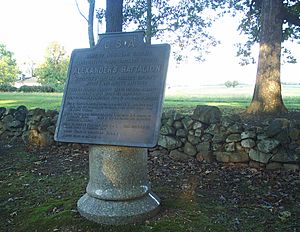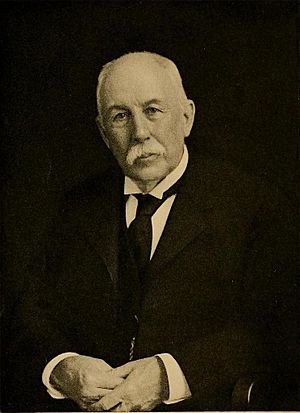Edward Porter Alexander facts for kids
Quick facts for kids
Edward Porter Alexander
|
|
|---|---|

Photo taken in 1866
|
|
| Born | May 26, 1835 Washington, Georgia |
| Died | April 28, 1910 (aged 74) Savannah, Georgia |
| Place of burial |
Magnolia Cemetery, Augusta, Georgia
|
| Allegiance | |
| Service/ |
|
| Years of service | 1857–61 (USA) 1861–65 (CSA) |
| Rank | |
| Commands held | Artillery |
| Battles/wars | |
| Other work | Railroad executive, planter, and author |
| Signature | |
Edward Porter Alexander (born May 26, 1835 – died April 28, 1910) was an American military engineer and writer. He also worked as a railroad executive. He first served as an officer in the United States Army. Later, during the American Civil War (1861–1865), he joined the Confederate Army. He rose to the rank of brigadier general.
Alexander was in charge of the huge artillery attack before Pickett's Charge. This happened on the third day of the Battle of Gettysburg. He was also known for using signals and observation balloons early in battles. After the Civil War, he taught math at the University of South Carolina. He also spent time in Nicaragua. He wrote many books and articles about the war. These writings are praised for being very clear and fair. His book Military Memoirs of a Confederate came out in 1907. Another book, Fighting for the Confederacy, was found after his death and published in 1989. It shares his personal story of military training and the war.
Contents
Early Life and Military Training
Edward Porter Alexander, known as Porter to his friends, was born in Washington, Georgia. His family was wealthy and owned large farms in the Southern United States. He was the sixth of ten children.
He went to the United States Military Academy at West Point. He graduated in 1857, ranking third in his class. He became a second lieutenant in the engineers. For a short time, he taught engineering at West Point. He also worked with Major Albert J. Myer. Myer invented the "wig-wag" signal flags. These flags were used for "aerial telegraphy," or sending messages over long distances. Alexander helped develop the Signal Corps.
In 1859, Alexander met Bettie Mason of Virginia. They married on April 3, 1860. They had six children together. Before the Civil War, Alexander's last jobs for the U.S. Army were in the Washington Territory and at Alcatraz Island in San Francisco.
Civil War Service
Joining the Confederacy
When his home state of Georgia left the United States, Alexander resigned from the U.S. Army. This was on May 1, 1861. He joined the Confederate Army as a captain of engineers. He helped organize and train new soldiers for the Confederate signal service.
He was sent to General P.G.T. Beauregard in Manassas Junction, Virginia. On June 3, he became the chief engineer and signal officer for the Confederate Army of the Potomac.
First Use of Signal Flags
At the First Battle of Bull Run, Alexander made history. He was the first to use signal flags to send a message during a battle over a long distance. He was on "Signal Hill" in Manassas. He saw Union troops moving. He quickly signaled to a Confederate brigade, "Look out for your left, your position is turned."
When General Beauregard and General Joseph E. Johnston got a similar message, they sent help. This help arrived just in time. It changed the battle, helping the Confederates win.
Alexander was promoted to major on July 1, 1861. He became a lieutenant colonel on December 31, 1861. During this time, he was chief of ordnance. This meant he managed supplies and ammunition. He also worked on signal and intelligence gathering. He dealt with spies working near Washington, D.C..
Key Artillery Roles
During the Peninsula Campaign in 1862, Alexander was still chief of ordnance. But he also fought at the Battle of Williamsburg. When Robert E. Lee took command of the army, Alexander prepared ammunition for Lee's attacks. He also gathered intelligence by going up in an observation balloon at Gaines' Mill. He went up several times and brought back important information about the Union Army's position.
Alexander continued to manage ammunition during the Northern Virginia Campaign (Second Bull Run) and the Maryland Campaign (Antietam). He almost got captured by Union cavalry.
Alexander is most famous as an artilleryman. He played a big part in many important battles. He became chief of artillery for James Longstreet's First Corps on November 7, 1862. He was promoted to colonel on December 5. He helped arrange the artillery at the Battle of Fredericksburg in December 1862. This was a key reason for the Confederate victory. He also helped Stonewall Jackson at the Battle of Chancellorsville in May 1863. His artillery positions there were very important.
Gettysburg Cannonade

At the Battle of Gettysburg, the Confederate artillery was not as strong as the Union's. They had fewer cannons and less good ammunition. Alexander, who was 28 years old, was in charge of the artillery attack for Pickett's Charge. He had to decide if the attack was ready. The bombardment lasted two hours. It was the biggest artillery attack of the war.
Union cannons stopped firing, making it seem like they were destroyed. But when Pickett's Charge began, the Union cannons opened fire. They caused many losses for the attackers. Alexander later wrote that a lot of ammunition was wasted earlier in the battle. He also said he did not have the power to use all the Confederate artillery for the attack. He believed Lee made mistakes at Gettysburg. He felt the Union position was too strong to attack.
Chief of Artillery for Longstreet
Alexander went with the First Corps to northern Georgia in late 1863. They were sent to help General Braxton Bragg at the Battle of Chickamauga. Alexander arrived too late for that battle. But he became Longstreet's chief of artillery in the Knoxville Campaign. He returned to Virginia with the corps in 1864. He was promoted to brigadier general on February 26, 1864.
He fought in all the battles of the Overland Campaign. When Ulysses S. Grant moved his army to attack Petersburg, Alexander quickly moved his cannons. He set them up to stop the main attack.
During the Siege of Petersburg, Alexander had to change his artillery tactics for trench warfare. He used different types of mortars. He thought the Union forces were digging tunnels under the Confederate lines. On June 30, 1864, he was wounded in the shoulder. He went on medical leave. He told Lee about his suspicion. The Battle of the Crater later surprised the Confederates, but they still won. Alexander returned to the army in February 1865. He oversaw the defenses of Richmond. He retreated with Lee's army in the Appomattox Campaign.
At Appomattox Court House, Alexander suggested to Lee that the army should scatter instead of surrendering. Lee disagreed. Alexander later regretted his idea. He wrote that he suggested the army "scatter in the woods & bushes" and try to join another Confederate army or return home.
Later Life and Writings
After the war, Alexander thought about joining the Brazilian Army. He decided he did not want to live on a Georgia farm anymore. He taught mathematics at the University of South Carolina. Then he worked as an executive for several railroads. One town, Youngsville, Alabama, was renamed Alexander City in his honor.

From 1892 to 1894, Alexander was on boards for river navigation and canal projects. He became friends with President Grover Cleveland. In 1897, President Cleveland appointed Alexander to a special commission. This commission was to set the border between Nicaragua and Costa Rica. This was important for a possible canal across Central America. Alexander spent two years leading this work. He returned to the U.S. in October 1899. His first wife, Bettie, died shortly after his return. In 1901, Alexander married Mary Mason, his first wife's niece.
In 1902, Alexander gave a speech at West Point. It was for the school's 100th anniversary. The speech was so good that The New York Times printed it all. President Theodore Roosevelt was in the audience.
Alexander became a well-respected author. He wrote many magazine articles. His book Military Memoirs of a Confederate: A Critical Narrative was published in 1907. Historians praised it as a very good analysis of the war. He also wrote a more personal memoir, Fighting for the Confederacy, which was published after his death in 1989.
Unlike some other Confederate officers, Alexander did not blame the North for the South's defeat. He was willing to criticize Confederate officers, even General Lee. Many historians believe Alexander's memoirs are among the most fair and insightful sources from the Civil War. Alexander also wrote other books like Railway Practice (1887).
Edward Porter Alexander died in Savannah, Georgia. He is buried in Magnolia Cemetery in Augusta, Georgia. In 2006, he was added to the Georgia Aviation Hall of Fame.
See also
 In Spanish: Edward Porter Alexander para niños
In Spanish: Edward Porter Alexander para niños


